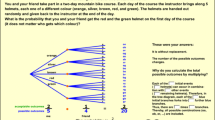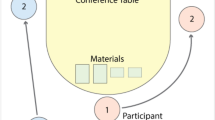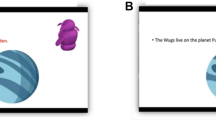Abstract
While authors like Mayer (2009) suggest that designers should avoid using visuals for the purpose of attracting learners’ interests, some scholars suggest that visuals could influence learners’ emotions. In this study the author investigated whether the perception of the visual appeal of instructional handouts affects learners’ self-reported motivation to learn from the handouts. Two handouts were prepared for this study: a minimalist handout following Mayer’s (2009) Coherence Principle and an appealing handout complying with everyday visual trends. Participants were instructed to look at the handouts in different orders according to groups and were asked about their impressions of the handouts. The appealing handout was perceived as motivating when it was seen after the minimalist handout. However, the group that saw the minimalist handout first did not perceive the appealing handout as motivating. The result implies that not only the design but also the learning context influences learners’ self-reported motivation to engage with the handout.







Similar content being viewed by others
Change history
09 December 2017
The original version of this article unfortunately contained a mistake. The abstract included some incorrect references to the order of treatment materials in the experiment reported.
References
Anglin, G. J., Vaez, V., & Cunningham, K. L. (2003). Visual representations and learning: The role of static and animated graphics. In D. H. Jonassen & M. P. Driscoll (Eds.), Handbook of research for educational communications and technology: A project of the Association for Educational Communications and Technology (2nd ed.). New York: Routledge.
Berleant, A. (2010). Art and Engagement (Reprint edition). Temple University Press.
Betrancourt, M. (2005). The animated and interactivity principles in multimedia learning. In The cambridge handbook of multimedia learning (1st ed., pp. 287–296). Cambridge: Cambridge University Press.
Csikszentmihalyi, M., & Robinson, R. E. (1991). The art of seeing: An interpretation of the aesthetic encounter. Los Angeles: J. Paul Getty Museum.
Dewey, J. (2005). Art as experience. New York: Berkley Publishing Group (Original work published 1934).
Dillon, A., & Jobst, J. (2005). Multimedia learning with hypermedia. In R. E. Mayer (Ed.), The cambridge handbook of multimedia learning (1st ed., pp. 569–588). Cambridge: Cambridge University Press.
Greenspan, S. I., & Benderly, B. L. (1998). The growth of the mind: And the endangered origins of intelligence. Reading: Da Capo Press.
Greenspan, S. I., & Shanker, S. (2004). The first idea how symbols, language, and intelligence evolved from our early primate ancestors to modern humans. Cambridge: Da Capo Press.
Hassenzahl, M. (2004). The interplay of beauty, goodness, and usability in interactive products. Human Computer Interaction, 19(4), 319–349. doi:10.1207/s15327051hci1904_2.
Hassenzahl, M., & Monk, A. (2010). The inference of perceived usability from beauty. Human Computer Interaction, 25(3), 235–260. doi:10.1080/07370024.2010.500139.
Kalyuga, S. (2005). Prior knowledge principle in multimedia learning. In R. E. Mayer (Ed.), The cambridge handbook of multimedia learning (1st ed., pp. 325–337). Cambridge: Cambridge University Press.
Keller, J. M., & Burkman, E. (1993). Motivation principles. In M. L. Fleming & W. H. Levie (Eds.), Instructional message design: Principles from the behavioral and cognitive sciences (2nd ed., pp. 3–53). Englewood Cliffs: Educational Technology Publications.
Mayer, R. E. (2005). Principles for reducing extraneous process in multimedia learning: Coherence, signals, redundancy, spatial contiguity, and temporal contiguity principles. In R. E. Mayer (Ed.), The cambridge handbook of multimedia learning (1st ed., pp. 325–337). Cambridge: Cambridge University Press.
Mayer, R. E. (2009). Multimedia learning (2nd ed.). Cambridge: Cambridge University Press.
Norman, D. (2002). Emotion & design: Attractive things work better. Interactions, 9(4), 36–42. doi:10.1145/543434.543435.
Parrish, P. (2005). Embracing the aesthetics of instructional design. Educational Technology, 45(2), 16–25.
Parrish, P. (2009). Aesthetic principles for instructional design. Educational Technology Research and Development, 57(4), 511–582. doi:10.1007/s11423-007-9060-7.
Rieber, L. P. (1994). Computers, graphics & learning. Madison, WI: Brown & Benchmark.
Rouet, J. F., & Potelle, H. (2005). Navigational principles in multimedia learning. In R. E. Mayer (Ed.), The cambridge handbook of multimedia learning (1st ed., pp. 297–312). Cambridge: Cambridge University Press.
Tomita, K. (2014). A review of visual attractiveness in instructional materials. Educational Studies (Institute for Educational Research and Service, International Christian University), 56, 165–173.
Top mobile apps by share of time spent. (2014). MarketingCharts. Retrieved from http://www.marketingcharts.com/online/top-mobile-apps-by-share-of-time-spent-45394/attachment/comscore-top-mobile-apps-by-consumption-age-group-aug2014/.
Uhrmacher, P. B. (2009). Toward a theory of aesthetic learning experiences. Curriculum Inquiry, 39(5), 613–636. doi:10.1111/j.1467-873X.2009.00462.x.
Winn, W. D. (1990). A theoretical framework for research on learning from graphics. International Journal of Educational Research, 14(6), 553–564. doi:10.1016/0883-0355(90)90025-4.
Winn, W. (1993). Perception principles. In M. L. Fleming & W. H. Levie (Eds.), Instructional message design: Principles from the behavioral and cognitive sciences (2nd ed., pp. 55–126). Englewood Cliffs, NJ: Educational Technology Publications.
Zajonc, R. B. (2001). Mere exposure: A gateway to the subliminal. Current Directions in Psychological Science, 10(6), 224–228. doi:10.1111/1467-8721.00154.
Author information
Authors and Affiliations
Corresponding author
Additional information
A correction to this article is available online at https://doi.org/10.1007/s11528-017-0242-9.
Rights and permissions
About this article
Cite this article
Tomita, K. Does the Visual Appeal of Instructional Media Affect Learners’ Motivation Toward Learning?. TechTrends 62, 103–112 (2018). https://doi.org/10.1007/s11528-017-0213-1
Published:
Issue Date:
DOI: https://doi.org/10.1007/s11528-017-0213-1




